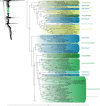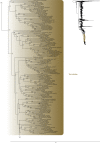Phylogeny of Dictyoptera: Dating the Origin of Cockroaches, Praying Mantises and Termites with Molecular Data and Controlled Fossil Evidence
- PMID: 26200914
- PMCID: PMC4511787
- DOI: 10.1371/journal.pone.0130127
Phylogeny of Dictyoptera: Dating the Origin of Cockroaches, Praying Mantises and Termites with Molecular Data and Controlled Fossil Evidence
Abstract
Understanding the origin and diversification of organisms requires a good phylogenetic estimate of their age and diversification rates. This estimate can be difficult to obtain when samples are limited and fossil records are disputed, as in Dictyoptera. To choose among competing hypotheses of origin for dictyopteran suborders, we root a phylogenetic analysis (~800 taxa, 10 kbp) within a large selection of outgroups and calibrate datings with fossils attributed to lineages with clear synapomorphies. We find the following topology: (mantises, (other cockroaches, (Cryptocercidae, termites)). Our datings suggest that crown-Dictyoptera-and stem-mantises-would date back to the Late Carboniferous (~ 300 Mya), a result compatible with the oldest putative fossil of stem-dictyoptera. Crown-mantises, however, would be much more recent (~ 200 Mya; Triassic/Jurassic boundary). This pattern (i.e., old origin and more recent diversification) suggests a scenario of replacement in carnivory among polyneopterous insects. The most recent common ancestor of (cockroaches + termites) would date back to the Permian (~275 Mya), which contradicts the hypothesis of a Devonian origin of cockroaches. Stem-termites would date back to the Triassic/Jurassic boundary, which refutes a Triassic origin. We suggest directions in extant and extinct species sampling to sharpen this chronological framework and dictyopteran evolutionary studies.
Conflict of interest statement
Figures









Similar articles
-
Fossil and phylogenetic analyses reveal recurrent periods of diversification and extinction in dictyopteran insects.Cladistics. 2020 Aug;36(4):394-412. doi: 10.1111/cla.12412. Epub 2020 Mar 13. Cladistics. 2020. PMID: 34619806
-
Identifying possible sister groups of Cryptocercidae+Isoptera: a combined molecular and morphological phylogeny of Dictyoptera.Mol Phylogenet Evol. 2015 Mar;84:284-303. doi: 10.1016/j.ympev.2014.08.019. Epub 2014 Sep 4. Mol Phylogenet Evol. 2015. PMID: 25194324
-
Genome size of termites (Insecta, Dictyoptera, Isoptera) and wood roaches (Insecta, Dictyoptera, Cryptocercidae).Naturwissenschaften. 2008 Sep;95(9):859-67. doi: 10.1007/s00114-008-0395-7. Epub 2008 May 31. Naturwissenschaften. 2008. PMID: 18516576
-
Wood-feeding cockroaches as models for termite evolution (Insecta: Dictyoptera): Cryptocercus vs. Parasphaeria boleiriana.Mol Phylogenet Evol. 2008 Mar;46(3):809-17. doi: 10.1016/j.ympev.2007.11.028. Epub 2007 Dec 7. Mol Phylogenet Evol. 2008. PMID: 18226554 Review.
-
Functional symbiosis and communication in microbial ecosystems. The case of wood-eating termites and cockroaches.Int Microbiol. 2015 Sep;18(3):159-69. doi: 10.2436/20.1501.01.246.. Int Microbiol. 2015. PMID: 27036743 Review.
Cited by
-
Paleopteran molecular clock: Time drift and recent acceleration.Ecol Evol. 2024 Sep 18;14(9):e70297. doi: 10.1002/ece3.70297. eCollection 2024 Sep. Ecol Evol. 2024. PMID: 39301292 Free PMC article.
-
Dating in the Dark: Elevated Substitution Rates in Cave Cockroaches (Blattodea: Nocticolidae) Have Negative Impacts on Molecular Date Estimates.Syst Biol. 2024 Sep 5;73(3):532-545. doi: 10.1093/sysbio/syae002. Syst Biol. 2024. PMID: 38320290 Free PMC article.
-
A novel form of wasp mimicry in a new species of praying mantis from the Amazon rainforest, Vespamantoida wherleyi gen. nov. sp. nov. (Mantodea, Mantoididae).PeerJ. 2019 Oct 17;7:e7886. doi: 10.7717/peerj.7886. eCollection 2019. PeerJ. 2019. PMID: 31656699 Free PMC article.
-
Architecture, construction, retention, and repair of faecal shields in three tribes of tortoise beetles (Coleoptera, Chrysomelidae, Cassidinae: Cassidini, Mesomphaliini, Spilophorini).Zookeys. 2023 Aug 30;1177:87-146. doi: 10.3897/zookeys.1177.102600. eCollection 2023. Zookeys. 2023. PMID: 37692321 Free PMC article.
-
Pervasive relaxed selection in termite genomes.Proc Biol Sci. 2024 May;291(2023):20232439. doi: 10.1098/rspb.2023.2439. Epub 2024 May 22. Proc Biol Sci. 2024. PMID: 38772424 Free PMC article.
References
-
- Heads M. Dating nodes on molecular phylogenies: a critique of molecular biogeography. Cladistics. 2005;21(1): 62–78. - PubMed
-
- Linder HP, Hardy CR, Rutschmann F. Taxon sampling effects in molecular clock dating: an example from the African Restionaceae. Mol Phylogenet Evol. 2005;35(3): 569–82. - PubMed
Publication types
MeSH terms
Grants and funding
LinkOut - more resources
Full Text Sources
Other Literature Sources
Molecular Biology Databases

